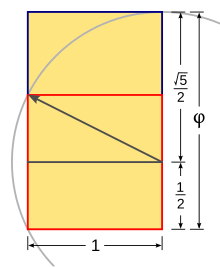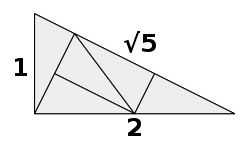Square root of 5
| Binary | 10.0011110001101111… |
| Decimal | 2.23606797749978969… |
| Hexadecimal | 2.3C6EF372FE94F82C… |
| Continued fraction | |
The square root of 5 is the positive real number that, when multiplied by itself, gives the prime number 5. It is more precisely called the principal square root of 5, to distinguish it from the negative number with the same property. This number appears in the fractional expression for the golden ratio. It can be denoted in surd form as:
It is an irrational algebraic number.[1] The first sixty significant digits of its decimal expansion are:
which can be rounded down to 2.236 to within 99.99% accuracy. As of December 2013, its numerical value in decimal has been computed to at least ten billion digits.[2]
Proofs of irrationality
This irrationality proof for the square root of 5 uses Fermat's method of infinite descent:
Suppose that √5 is rational, and express it in lowest possible terms (i.e., as a fully reduced fraction) as m/n for natural numbers m and n. Then √5 can be expressed in lower terms as 5n − 2m/m − 2n, which is a contradiction.[3] (The two fractional expressions are equal because equating them, cross-multiplying, and canceling like additive terms gives 5n2 = m2 and m/n = √5, which is true by the premise. The second fractional expression for √5 is in lower terms since, comparing denominators, m − 2n < n since m < 3n since m/n < 3 since √5 < 3. And both the numerator and the denominator of the second fractional expression are positive since 2 < √5 < 5/2 and m/n = √5.)
This irrationality proof is a proof by contradiction:
Suppose that √5 = a/b where a/b is in reduced form.
Thus 5 = a2/b2 and 5b2 = a2. If b was even, b2, a2, and a would be even making the fraction a/b not in reduced form. Thus b is odd, and by following a similar process, a is odd.
Now, let a = 2m + 1 and b = 2n + 1 where m and n are integers.
Substituting into 5b2 = a2 we get:
which simplifies to:
making:
By subtracting 1 from both sides, we get:
which reduces to:
In other words:
The expression x(x + 1) is even for any integer x (since either x or x + 1 is even). So what this is saying is 5 × even + 1 = even, or odd = even. There is no integer that's both even and odd thus we've reached a contradiction and √5 is irrational.
Continued fraction
It can be expressed as the continued fraction [2; 4, 4, 4, 4, 4...] (sequence A040002 in the OEIS). The sequence of best rational approximations is:
Convergents of the continued fraction are colored red; their numerators are 2, 9, 38, 161, ... (sequence A001077 in the OEIS), and their denominators are 1, 4, 17, 72, ... (sequence A001076 in the OEIS). The other (black) terms are semiconvergents.
Babylonian method
When √5 is computed with the Babylonian method, starting with r0 = 2 and using rn+1 = 1/2(rn + 5/rn), the nth approximant rn is equal to the 2nth convergent of the convergent sequence:
Nested square expansions
The following nested square expressions converge to :
Relation to the golden ratio and Fibonacci numbers

This golden ratio φ is the arithmetic mean of 1 and √5.[4] The algebraic relationship between √5, the golden ratio and the conjugate of the golden ratio (Φ = 1/φ = φ − 1) are expressed in the following formulae:
(See section below for their geometrical interpretation as decompositions of a √5 rectangle.)
√5 then naturally figures in the closed form expression for the Fibonacci numbers, a formula which is usually written in terms of the golden ratio:
The quotient of √5 and φ (or the product of √5 and Φ), and its reciprocal, provide an interesting pattern of continued fractions and are related to the ratios between the Fibonacci numbers and the Lucas numbers:[5]
The series of convergents to these values feature the series of Fibonacci numbers and the series of Lucas numbers as numerators and denominators, and vice versa, respectively:
and
Geometry

Geometrically, √5 corresponds to the diagonal of a rectangle whose sides are of length 1 and 2, as is evident from the Pythagorean theorem. Such a rectangle can be obtained by halving a square, or by placing two equal squares side by side. Together with the algebraic relationship between √5 and φ, this forms the basis for the geometrical construction of a golden rectangle from a square, and for the construction of a regular pentagon given its side (since the side-to-diagonal ratio in a regular pentagon is φ).
Forming a dihedral right angle with the two equal squares that halve a 1:2 rectangle, it can be seen that √5 corresponds also to the ratio between the length of a cube edge and the shortest distance from one of its vertices to the opposite one, when traversing the cube surface (the shortest distance when traversing through the inside of the cube corresponds to the length of the cube diagonal, which is the square root of three times the edge).[citation needed]
The number √5 can be algebraically and geometrically related to √2 and √3, as it is the length of the hypotenuse of a right triangle with catheti measuring √2 and √3 (again, the Pythagorean theorem proves this). Right triangles of such proportions can be found inside a cube: the sides of any triangle defined by the centre point of a cube, one of its vertices, and the middle point of a side located on one the faces containing that vertex and opposite to it, are in the ratio √2:√3:√5. This follows from the geometrical relationships between a cube and the quantities √2 (edge-to-face-diagonal ratio, or distance between opposite edges), √3 (edge-to-cube-diagonal ratio) and √5 (the relationship just mentioned above).
A rectangle with side proportions 1:√5 is called a root-five rectangle and is part of the series of root rectangles, a subset of dynamic rectangles, which are based on √1 (= 1), √2, √3, √4 (= 2), √5… and successively constructed using the diagonal of the previous root rectangle, starting from a square.[6] A root-5 rectangle is particularly notable in that it can be split into a square and two equal golden rectangles (of dimensions Φ × 1), or into two golden rectangles of different sizes (of dimensions Φ × 1 and 1 × φ).[7] It can also be decomposed as the union of two equal golden rectangles (of dimensions 1 × φ) whose intersection forms a square. All this is can be seen as the geometric interpretation of the algebraic relationships between √5, φ and Φ mentioned above. The root-5 rectangle can be constructed from a 1:2 rectangle (the root-4 rectangle), or directly from a square in a manner similar to the one for the golden rectangle shown in the illustration, but extending the arc of length √5/2 to both sides.
Trigonometry
Like √2 and √3, the square root of 5 appears extensively in the formulae for exact trigonometric constants, including in the sines and cosines of every angle whose measure in degrees is divisible by 3 but not by 15.[8] The simplest of these are
As such the computation of its value is important for generating trigonometric tables.[citation needed] Since √5 is geometrically linked to half-square rectangles and to pentagons, it also appears frequently in formulae for the geometric properties of figures derived from them, such as in the formula for the volume of a dodecahedron.[citation needed]
Diophantine approximations
Hurwitz's theorem in Diophantine approximations states that every irrational number x can be approximated by infinitely many rational numbers m/n in lowest terms in such a way that
and that √5 is best possible, in the sense that for any larger constant than √5, there are some irrational numbers x for which only finitely many such approximations exist.[9]
Closely related to this is the theorem[10] that of any three consecutive convergents pi/qi, pi+1/qi+1, pi+2/qi+2, of a number α, at least one of the three inequalities holds:
And the √5 in the denominator is the best bound possible since the convergents of the golden ratio make the difference on the left-hand side arbitrarily close to the value on the right-hand side. In particular, one cannot obtain a tighter bound by considering sequences of four or more consecutive convergents.[10]
Algebra
The ring ℤ[√−5] contains numbers of the form a + b√−5, where a and b are integers and √−5 is the imaginary number i√5. This ring is a frequently cited example of an integral domain that is not a unique factorization domain.[citation needed] The number 6 has two inequivalent factorizations within this ring:
The field ℚ[√−5], like any other quadratic field, is an abelian extension of the rational numbers. The Kronecker–Weber theorem therefore guarantees that the square root of five can be written as a rational linear combination of roots of unity:
Identities of Ramanujan
The square root of 5 appears in various identities of Ramanujan involving continued fractions.[11][12]
For example, this case of the Rogers–Ramanujan continued fraction:
See also
References
- ^ Dauben, Joseph W. (June 1983) Scientific American Georg Cantor and the origins of transfinite set theory. Volume 248; Page 122.
- ^ Lukasz Komsta: Computations page
- ^ Grant, Mike, and Perella, Malcolm, "Descending to the irrational", Mathematical Gazette 83, July 1999, pp.263-267.
- ^ Browne, Malcolm W. (July 30, 1985) New York Times Puzzling Crystals Plunge Scientists into Uncertainty. Section: C; Page 1. (Note - this is a widely cited article).
- ^ Richard K. Guy: "The Strong Law of Small Numbers". American Mathematical Monthly, vol. 95, 1988, pp. 675–712
- ^ Kimberly Elam (2001), Geometry of Design: Studies in Proportion and Composition, New York: Princeton Architectural Press, ISBN 1-56898-249-6
- ^ Jay Hambidge (1967), The Elements of Dynamic Symmetry, Courier Dover Publications, ISBN 0-486-21776-0
- ^ Julian D. A. Wiseman, "Sin and cos in surds"
- ^ LeVeque, William Judson (1956), Topics in number theory, Addison-Wesley Publishing Co., Inc., Reading, Mass., MR 0080682
- ^ a b Khinchin, Aleksandr Yakovlevich (1964), Continued Fractions, University of Chicago Press, Chicago and London
- ^ Ramanathan, K. G. (1984), "On the Rogers-Ramanujan continued fraction", Indian Academy of Sciences. Proceedings. Mathematical Sciences, 93 (2): 67–77, doi:10.1007/BF02840651, ISSN 0253-4142, MR 0813071
- ^ Eric W. Weisstein, Ramanujan Continued Fractions at MathWorld



















![{\displaystyle {\frac {\sqrt {5}}{\varphi }}=\Phi \cdot {\sqrt {5}}={\frac {5-{\sqrt {5}}}{2}}=1.3819660112501051518\dots =[1;2,1,1,1,1,1,1,1,\dots ]}](https://wikimedia.org/api/rest_v1/media/math/render/svg/897e8abc1620309ed4a9c4ce466cc4b468279475)
![{\displaystyle {\frac {\varphi }{\sqrt {5}}}={\frac {1}{\Phi \cdot {\sqrt {5}}}}={\frac {5+{\sqrt {5}}}{10}}=0.72360679774997896964\dots =[0;1,2,1,1,1,1,1,1,\dots ].}](https://wikimedia.org/api/rest_v1/media/math/render/svg/e5c5c2a550a1ff46be0bb2fa9f2ae0794253eea9)
![{\displaystyle {1,{\frac {3}{2}},{\frac {4}{3}},{\frac {7}{5}},{\frac {11}{8}},{\frac {18}{13}},{\frac {29}{21}},{\frac {47}{34}},{\frac {76}{55}},{\frac {123}{89}}},\dots \dots [1;2,1,1,1,1,1,1,1,\dots ]}](https://wikimedia.org/api/rest_v1/media/math/render/svg/82a70f0d2d9e7b7b1610d3477bc2717274a6a590)
![{\displaystyle {1,{\frac {2}{3}},{\frac {3}{4}},{\frac {5}{7}},{\frac {8}{11}},{\frac {13}{18}},{\frac {21}{29}},{\frac {34}{47}},{\frac {55}{76}},{\frac {89}{123}}},\dots \dots [0;1,2,1,1,1,1,1,1,\dots ].}](https://wikimedia.org/api/rest_v1/media/math/render/svg/5dd56830ef6a47257270f35032fa3443c1a65da2)






![{\displaystyle {\cfrac {1}{1+{\cfrac {e^{-2\pi {\sqrt {5}}}}{1+{\cfrac {e^{-4\pi {\sqrt {5}}}}{1+{\cfrac {e^{-6\pi {\sqrt {5}}}}{1+\ddots }}}}}}}}=\left({{\sqrt {5}} \over 1+{\sqrt[{5}]{5^{\frac {3}{4}}(\varphi -1)^{\frac {5}{2}}-1}}}-\varphi \right)e^{\frac {2\pi }{\sqrt {5}}}.}](https://wikimedia.org/api/rest_v1/media/math/render/svg/6a27488241b72ae7dc4f1c9e1e44cbae1bea14b6)
